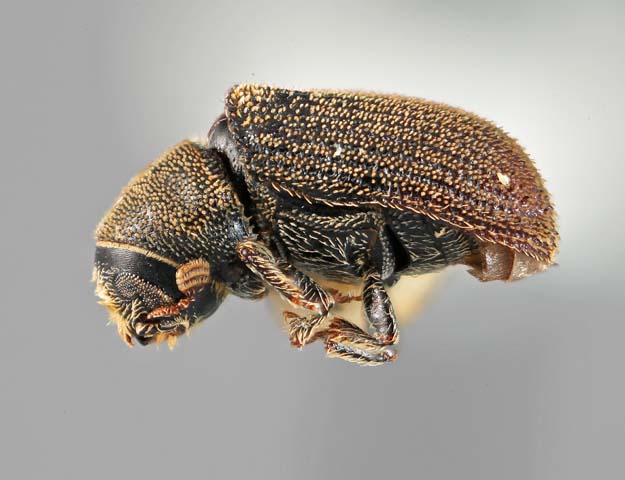Carphoborus pinicolens Wood 1954


 Images: Displaying 1 to 8 of 11
Images: Displaying 1 to 8 of 11 




 Carphoborus pinicolens (male)
Carphoborus pinicolens (male) |
 Carphoborus pinicolens (male)
Carphoborus pinicolens (male) |
 Carphoborus pinicolens (male)
Carphoborus pinicolens (male) |
 Carphoborus pinicolens (male)
Carphoborus pinicolens (male) |
 Carphoborus pinicolens (male)
Carphoborus pinicolens (male) |
 Carphoborus pinicolens (male)
Carphoborus pinicolens (male) |
 Carphoborus pinicolens (female)
Carphoborus pinicolens (female) |
 Carphoborus pinicolens (female)
Carphoborus pinicolens (female) |
| Next > |

Carphoborus pinicolens (female) (by SM Smith, Michigan State University). holotype Carphoborus pinicolens Wood. This image is the property of the National Museum of Natural History, Smithsonian Institution, Washington, D.C., used under CC0 license
 Summary of Information
Summary of Information





SYNONYMY
- Carphoborus blaisdelli Bruck 1936. Bull. S. Calif. Acad. Sci. 35: 116
- Carphoborus simplex Bruck 1936. Bull. S. Calif. Acad. Sci. 35: 113
- Carphoborus simplex Wood 1951. Proc. Utah Acad. Sci. Arts Let. 26: 127
- Carphoborus pinicolens Wood 1954. Can. Ent. 86: 512
- Carphoborus tuberculatus Bright 1964. Pan. Pac. Ent. 40: 165
DISTRIBUTION.
Numbers in parentheses after each geographic unit are the number of distinct collection events in the database for that unit. For exotic species generally only countries are listed for localities outside the New World. For further information on published sources of distribution, check the REFERENCES section.
Distribution Comments. Coasta and internior western North America from Montana to Baja California, including the isolated area of southern Bajka California. It has been collected in southern Arizona near the Mexican border and likely occurs in Chihuahua and Sonora as well.
There are no distribution records in the database
HOSTS
Numbers in parentheses after each host family, genus, or collection method are the number of distinct collection events in the database for that host or method.
REFERENCES
The following are important recent monographs, catalogs, and supplements to catalogs that refer to this species. The specific page on which the reference is made is shown in pink at the end of the reference. In the case of Wood (1982) and Wood & Bright (1992) clicking on the reference page will link to a digital version of the work in question.
- Wood, S.L. 1982. The bark and ambrosia beetles of North and Central America (Coleoptera: Scolytidae), a taxonomic monograph. Great Basin Nat. Mem. 6:1-1356. [377]. (data capture complete)
- Wood, S.L., Bright,D.E. 1992. A catalog of Scolytidae and Platypodidae (Coleoptera), Part 2. Taxonomic Index. Great Basin Nat. Mem. 13:1-1553 (vol. A, B). [308]
The following are references from which host and distribution data have been input into the database. If one of the above monographs or catalogs also appears in this list, it means that most relevant collection event data have been included.
- . . .
- Atkinson, T.H. 2024. New species, new synonymy, taxonomic notes and new records of bark and ambrosia beetles from the southwestern United States and northern Mexico (Coleoptera: Curculionidae: Platypodinae and Scolytinae). Zootaxa 5424 (2): 151-175.
- Bright, D.E. 1964. Descriptions of three new species and distribution records of California bark beetles (Coleoptera: Scolytidae). Pan-Pacific Entomologist 40(3): 165-170.
- Bright, D.E., Skidmore, R.E. 2002. A Catalog of Scolytidae and Platypodidae (Coleoptera), Supplement 2 (1995-1999). NRC Research Press. Ottawa, Ontario, Canada.
- Bright, D.E., Stark, R.W. 1973. The bark and ambrosia beetles of California. Coleoptera: Scolytidae and Platypodidae. Bull. Calif. Insect Surv. 16: 1-169.
- EDRR 2011. USFS Early Detection Rapid Response Database. http://www.fs.fed.us/invasivespecies/earlydetection.shtml/.
- Gast,S.J.; Furniss,M.M.; Johnson,J.B.; Ivie,M.A. 1989. List of Montana Scolytidae (Coleoptera) and notes on new records. Great Basin Nat. 49(3): 381-386.
- University of Arizona Insect Collection 2016. SCAN: Symbiota Collections of Arthropods Network. http://symbiota4.acis.ufl.edu/scan/portal/collections/misc/collprofiles.php?collid=11.
- Wood, S.L. 1951. The Scolytidae of the Logan Canyon area in Utah and their host plants. Proc.Utah Acad.Sci.Arts Letters 26 : 127-128.
- Wood, S.L. 1954. Bark beetles of the genus Carphoborus Eichhoff (Coleoptera: Scolytidae) in North America. Can. Entomol. 86(11): 502-526.
- Wood, S.L. 1982. The bark and ambrosia beetles of North and Central America (Coleoptera: Scolytidae), a taxonomic monograph. Great Basin Nat. Mem. 6: 1-1356.
 Distribution Map
Distribution Map





Maps automatically open at the center of the plotted points and the scale is set to encompass all map points. Maps can be resized (scale bar at upper left) and the center moved (place cursor over map and drag) to see other parts of the distribution of the species. Clicking on a map marker will pull up collection event data and a literature citation if present. If any errors are found, please refer to the "series code" which is a unique identifier for a database record in any communications). Coordinates have not been entered for all collection records. Localities outside the New World are not plotted, even though they are listed in the distribution summary and in the table of records.
There are no distribution records in the database
 Collection Records
Collection Records





There are no distribution records in the database
Return to top of page
